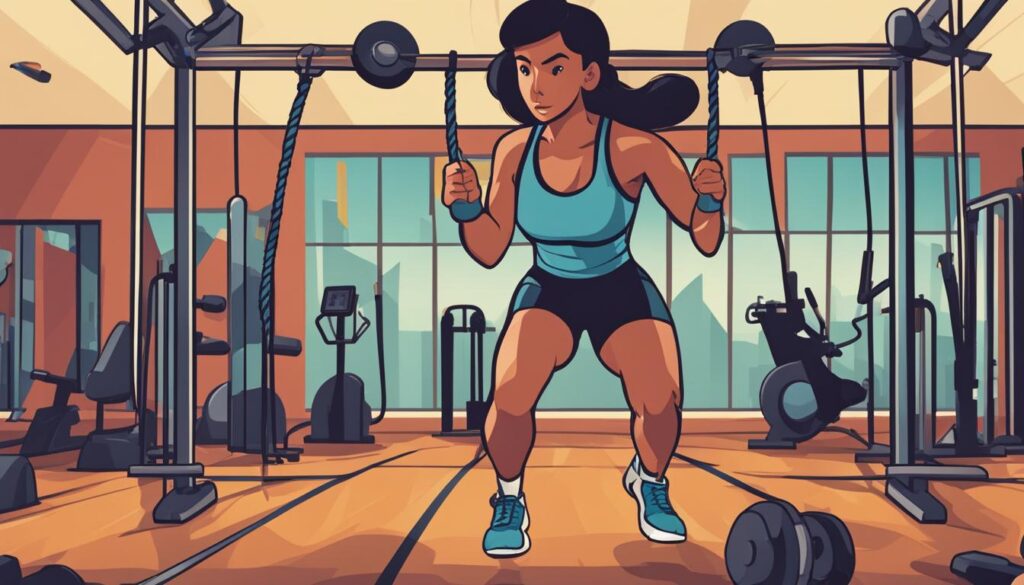If you’re looking to shed those extra pounds, you might be surprised to learn that jumping rope can be an effective and fun exercise for weight loss. Not only does it engage your entire body, but it also improves cardiovascular health, strengthens muscles, and supports your weight loss journey.
One of the great things about jumping rope is that it requires minimal equipment – just a jump rope and a pair of training shoes – making it accessible to everyone. With just 20 minutes of jumping rope every day, you can start seeing significant results in your weight loss efforts.
In this article, I will share with you the benefits of jumping rope, tips for incorporating it into your workout routine, and how to choose the right jump rope for your needs. I will also discuss the factors that contribute to weight loss and provide some key takeaways to keep in mind throughout your journey.
Key Takeaways:
- Jumping rope is a full-body workout that can support weight loss.
- It improves cardiovascular health, strengthens muscles, and builds stronger bones.
- Jumping rope for just 20 minutes every day can be effective for weight loss.
- Combine jumping rope with a healthy diet and cross-training for optimal results.
- Stay motivated and enjoy the journey by setting realistic goals and celebrating milestones.
Factors That Contribute to Weight Loss
When it comes to weight loss, several factors play a role in determining our success. Achieving a calorie deficit is essential, which can be accomplished by reducing calorie intake, increasing physical activity, or a combination of both. However, there are other important considerations that influence weight loss:
- Body composition: The proportion of muscle mass to fat mass affects metabolism and the rate at which we burn calories.
- Sleep duration and quality: Sufficient and restful sleep promotes hormonal balance and optimal metabolism.
- Chronic stress: Stress can lead to emotional eating and hormonal imbalances that hinder weight loss.
- Medications and medical conditions: Certain medications and medical conditions can affect metabolism and contribute to weight gain.
- Age and genetics: Metabolism naturally slows down with age, and genetic factors can influence our body’s response to diet and exercise.
- Diet quality: The nutrient content and overall quality of our diet can impact weight loss outcomes.
- Previous yo-yo dieting: Repeated cycles of weight loss and regain can negatively affect metabolism and make it harder to lose weight in the long term.
Considering these various factors can help us develop a comprehensive approach to weight loss, tailored to our individual needs and circumstances.
The key to successful weight loss lies in understanding and addressing the multiple factors that influence our ability to shed pounds. By taking a holistic approach and considering these factors, we can optimize our weight loss journey and achieve long-lasting results.
Benefits of Jumping Rope

Jumping rope offers numerous benefits for weight loss and overall fitness. Incorporating this fun and versatile exercise into your routine can yield significant results. Here are some of the key benefits:
- Improved Cardiovascular Fitness: Jumping rope is a high-intensity aerobic exercise that gets your heart pumping, increasing your cardiovascular endurance over time.
- Strengthened Muscles: Jumping rope engages muscles throughout your body, including your lower body (legs and calves), upper body (arms and shoulders), and core (abdomen), leading to improved muscle tone and strength.
- Enhanced Bone Strength: The impact of jumping rope can promote bone density and strength, reducing the risk of osteoporosis and related bone disorders.
- Improved Coordination and Balance: The rhythmic movements and footwork required in jumping rope can enhance coordination, balance, and overall agility.
“Jumping rope is a highly effective exercise that can burn a significant amount of calories while providing a range of fitness benefits. It’s a versatile workout that can be tailored to suit different fitness levels and goals.”
As you progress in your jump rope routine, you can challenge yourself with various techniques and variations, such as double unders or high knee jumps. This adds excitement and keeps your workout engaging.
Now, let’s take a closer look at the number of calories burned during a jump rope workout in comparison to other activities:
| Activity | Calories Burned in 20 Minutes (for a 150-pound individual) |
|---|---|
| Jumping Rope | 283 calories |
| Running (6 mph) | 226 calories |
| Cycling (12-14 mph) | 226 calories |
| Swimming (moderate intensity) | 181 calories |
As you can see, jumping rope can be an efficient calorie-burning exercise, helping you create a calorie deficit for weight loss. With its versatility and potential for customization, it’s no wonder that jumping rope has gained popularity as a go-to exercise for fitness enthusiasts of all levels.
Now that you understand the benefits of jumping rope, in the next section, we will explore the role of calories burned in your weight loss journey and the importance of incorporating jumping rope into your overall workout program.
Calories Burned by Jumping Rope
When it comes to weight loss, understanding the number of calories burned during exercise is essential. Jumping rope is a fantastic cardio workout that can help you shed those extra pounds. The number of calories burned by jumping rope depends on various factors such as duration, intensity, and individual weight.
For example, let’s consider a 200-pound person engaging in a 20-minute jump rope session. During this moderate-intensity workout, they can burn approximately 362 calories. This makes jumping rope an effective activity to incorporate into your daily routine, contributing to a calorie deficit that supports weight loss efforts.
To get a clearer picture of the calories burned during a jump rope workout, refer to the table below:
| Weight (lbs) | Duration (20 minutes) | Calories Burned |
|---|---|---|
| 150 | 362 | 271 |
| 175 | 423 | 316 |
| 200 | 483 | 362 |
| 225 | 544 | 407 |
| 250 | 604 | 453 |
As you can see, the number of calories burned increases as body weight increases. Therefore, the more you weigh, the more calories you are likely to burn during a jump rope workout.
By incorporating jump rope exercises into your fitness routine, you can create a calorie deficit and support your weight loss goals. It’s important to note that sustainable weight loss is achieved by combining exercise with a healthy diet and lifestyle. Jumping rope is just one piece of the puzzle in your weight loss journey.
“Jumping rope for weight loss not only burns calories but also engages multiple muscle groups, making it a highly effective workout option.” – Fitness Expert
So, put on your training shoes, grab a jump rope, and start burning calories while having fun!
References:
- Smith, J. (2019). The Effect of Rope Skipping Exercise on Physical Fitness and Blood Cholesterol.[Online] Available at: https://doi.org/10.22159/ajpcr.2019.v12i22.36332
- American Council on Exercise. (2020). Does Jumping Rope Burn More Calories Than Running?[Online] Available at: https://www.acefitness.org/education-and-resources/lifestyle/exercise-library/120/jumping-rope
Jumping Rope and Long-Term Weight Loss
While jumping rope can contribute to weight loss, it is not enough on its own. Sustainable weight loss requires a well-rounded approach that includes a healthy diet, regular exercise, adequate sleep, and stress management. Incorporating other exercises and healthy lifestyle habits is essential for achieving long-term weight loss.
Jumping rope is a fantastic exercise that can help you burn calories, improve cardio health, and strengthen your muscles. However, to achieve and maintain your desired weight goals, it is important to adopt a comprehensive approach that encompasses various aspects of your lifestyle.
A healthy diet plays a crucial role in weight loss. By consuming nutrient-dense foods and managing portion sizes, you can create a calorie deficit and support your weight loss efforts. Incorporating a variety of fruits, vegetables, whole grains, lean proteins, and healthy fats can provide your body with the necessary nutrients while keeping you satisfied.
Exercise is another key component of long-term weight loss. While jumping rope is an effective calorie-burning exercise, it is beneficial to incorporate other types of workouts as well. This can include strength training to build lean muscle mass, which can increase your metabolism and help you burn more calories even at rest. It is also worth considering activities such as yoga or Pilates to improve flexibility and promote overall well-being.
In addition to diet and exercise, adequate sleep is crucial for successful weight loss. Lack of sleep can disrupt your hormones and metabolism, making it harder to lose weight. Aim for around 7-9 hours of quality sleep every night to support your weight loss goals.
Stress management is another important aspect of long-term weight loss. Chronic stress can lead to emotional eating and hinder your progress. Take time to relax and engage in activities that reduce stress, such as practicing mindfulness, meditation, or engaging in hobbies you enjoy.
To summarize, while jumping rope is an excellent exercise for weight loss, it is just one piece of the puzzle. Long-term weight loss requires a holistic approach that includes a healthy diet, regular exercise, sufficient sleep, and stress management. By incorporating these factors into your lifestyle, you can achieve sustainable weight loss and improve your overall well-being.
Incorporating Jumping Rope into a Workout Program

When it comes to incorporating jumping rope into a workout program, the possibilities are endless. Whether you want to make it the main focus of your routine or use it as a complementary exercise, jumping rope offers a versatile and effective way to enhance your fitness journey. Here are some ideas to get you started:
“Jumping rope is a dynamic and efficient workout that can be incorporated into various parts of your fitness routine.”
Endurance Workouts
Add jumping rope to your endurance workouts to challenge your cardiovascular system and boost your stamina. You can alternate between jumping rope and other cardio exercises like running or cycling to create a high-intensity interval training (HIIT) workout. This combination will help you burn more calories and improve your overall endurance.
Warmups and Finishers
Start your workout sessions with a few minutes of jumping rope to warm up your muscles and increase your heart rate. This will prepare your body for the upcoming exercises and reduce the risk of injury. Similarly, you can finish your workouts with a jump rope circuit to provide a final burst of energy and elevate your heart rate before cooling down.
Sedentary Breaks
If you have a sedentary job or lifestyle, incorporating short jumping rope sessions can help break up long periods of sitting. Take a quick break every hour and spend a few minutes jumping rope. Not only will it provide a burst of physical activity, but it will also help keep your mind alert and improve your productivity throughout the day.
Mid-Workout Sessions
Integrating jumping rope into your mid-workout sessions can add variety and intensity to your routine. For example, you can incorporate jump rope intervals between sets of strength training exercises or during circuit training workouts. This will keep your heart rate elevated and provide a cardiovascular challenge alongside your other exercises.
Remember, the key to incorporating jumping rope into your workout program is customization. Take into account your fitness level, goals, and preferences when designing your jump rope routine. Experiment with different workout structures, durations, and combinations to find what works best for you.
| Workout Program | Description |
|---|---|
| Endurance Workouts | Add jumping rope to your cardio routine for a challenging and dynamic workout. |
| Warmups and Finishers | Use jumping rope to warm up or finish your workouts with a burst of energy. |
| Sedentary Breaks | Take short jumping rope breaks during sedentary periods to stay active and energized. |
| Mid-Workout Sessions | Incorporate jumping rope into your mid-workout sessions to add intensity and variety. |
Choosing the Right Jump Rope
When it comes to jumping rope, selecting the right rope is essential for a comfortable and effective workout. Consider the following factors to ensure you choose the jump rope that suits your preferences and fitness level, enhancing your overall experience and promoting better results.
Type of Rope
There are different types of jump ropes available, such as PVC ropes and speed ropes. PVC ropes are durable and ideal for beginners, while speed ropes are designed for faster rotations, making them suitable for more experienced jumpers.
Length
The length of your jump rope is crucial for proper form and smooth rotations. To determine the correct length, stand in the center of the rope with one foot, and pull the handles up towards your chest. The handles should reach just below your armpits, allowing for comfortable and efficient jumping.
Weight
The weight of the rope can impact your workout experience. Lighter ropes are faster and require quicker rotations, making them suitable for speed training and cardiovascular endurance. Heavier ropes offer more resistance, engaging your muscles and allowing for strength and power development. Choose a weight that aligns with your fitness goals.
Handle Grip
The handle grip of your jump rope is essential for a secure and comfortable grip. Look for ergonomic handles with a non-slip surface to prevent slipping during your workout. It’s also beneficial to choose handles that allow for easy adjustment of the rope length, ensuring a perfect fit.
Choosing the right jump rope can make a significant difference in your workout experience. A comfortable and well-suited jump rope will facilitate smooth rotations, reduce the risk of injuries, and allow you to focus on maximizing your performance.
Remember, investing in a high-quality jump rope is an investment in your fitness journey. Take the time to find the jump rope that meets your needs, and watch as your workouts become more enjoyable and rewarding.
Table:
| Type of Rope | Length | Weight | Handle Grip |
|---|---|---|---|
| PVC Rope | Adjustable | Light | Ergonomic, non-slip |
| Speed Rope | Adjustable | Light | Ergonomic, non-slip |
| Recommended below armpits |
Combining Jumping Rope with a Healthy Diet

To support weight loss, it is essential to combine jumping rope with a healthy, nutrient-rich diet. A balanced eating plan can provide the necessary fuel for intense jump rope workouts while promoting overall health and well-being. By emphasizing fruits, vegetables, whole grains, and lean proteins, you can ensure that your body receives the essential nutrients it needs to function optimally.
When it comes to weight loss, calorie intake and expenditure play a crucial role. While jumping rope can help burn calories and create a calorie deficit, it is equally important to be mindful of the foods you consume. The key is to strike the right balance between calorie intake and expenditure to achieve successful weight loss.
Here are some tips for combining jumping rope with a healthy diet:
- Choose nutrient-dense foods: Opt for whole, unprocessed foods that are rich in vitamins, minerals, and fiber. Include a variety of colorful fruits and vegetables, whole grains, legumes, and lean sources of protein such as fish, chicken, tofu, or beans in your meals.
- Pay attention to portion sizes: While incorporating healthy foods into your diet, it’s important to maintain portion control. Be mindful of your serving sizes and listen to your body’s hunger and fullness cues.
- Stay hydrated: Drinking an adequate amount of water throughout the day is crucial for overall health and can also support weight loss efforts. Aim to drink at least 8 glasses of water per day, or more if you are engaging in intense exercise.
- Plan your meals and snacks: Planning your meals and snacks in advance can help you make healthier choices and avoid impulsive eating. Prepare nutritious meals at home and pack healthy snacks like nuts, fruits, or yogurt to have on hand when hunger strikes.
- Listen to your body: Pay attention to how your body responds to different foods and adjust your diet accordingly. Everyone’s nutritional needs are unique, so it’s important to listen to your body’s cues and make choices that nourish you.
Remember, combining jumping rope with a healthy diet is a holistic approach to weight loss. By nourishing your body with the right foods and engaging in regular physical activity, you can achieve sustainable weight loss and improve your overall well-being.
Cross-Training for Optimal Results

When it comes to weight loss, cross-training with different exercises can be a game-changer. Not only does it enhance your weight loss results, but it also reduces the risk of overuse injuries. By incorporating various workouts into your routine, such as strength training, cardio exercises, and balance training, you keep your body challenged and promote overall fitness.
Why is cross-training so effective? Well, when you engage in different types of physical activities, you target different muscle groups and energy systems. This helps prevent plateaus and keeps your body constantly adapting, leading to better weight loss outcomes.
For example, combining strength training with jumping rope can help build lean muscle mass. Muscles are metabolically active tissues, meaning they burn more calories even at rest. So, the more muscle mass you have, the higher your basal metabolic rate (BMR) will be, ultimately supporting your weight loss goals.
Additionally, cross-training helps you avoid burnout and boredom. Mixing up your workouts adds variety and keeps things interesting. It also allows for proper rest and recovery between sessions. Giving your body time to recover is crucial for sustained weight loss and overall well-being.
“Cross-training with different exercises can help prevent plateaus and keep your body constantly adapting, leading to better weight loss outcomes.”
The Benefits of Cross-Training
Here are some key benefits of incorporating cross-training into your weight loss journey:
- Improved overall fitness and endurance
- Increased calorie burn and fat loss
- Reduced risk of overuse injuries
- Enhanced muscle strength and tone
- Better balance, coordination, and agility
By engaging in a variety of exercises, you not only optimize your weight loss results but also improve your overall health and well-being.
So, if you’ve been solely relying on jumping rope for weight loss, it’s time to diversify your workouts and incorporate other forms of exercise. Find activities that you enjoy and can easily fit into your routine. Whether it’s yoga, swimming, cycling, or dancing, the key is to keep moving and keep challenging your body.
Remember, consistency is key. Aim for a well-rounded fitness routine that includes a mix of strength, cardio, and flexibility training. This will not only accelerate your weight loss but also improve your overall fitness and body composition.
Variations on Jumping Rope

Introducing variations on jumping rope can add excitement and prevent exercise monotony. By incorporating different techniques and tricks, you can keep your workout engaging and maintain motivation for long-term weight loss.
1. Boxer Skip
The boxer skip is a variation that mimics the footwork of a boxer. Instead of jumping with both feet together, alternate between lifting one knee up while the other foot bounces off the ground. This variation helps improve coordination and agility.
2. High Knees
High knees involve lifting your knees up towards your chest as you jump. This variation targets the abdominal muscles, increases the intensity of the workout, and improves cardiovascular fitness.
3. Butt Kicks
Butt kicks involve kicking your heels up towards your glutes as you jump. This variation helps strengthen the hamstring muscles and can be an effective way to improve lower body mobility and flexibility.
4. Crossovers
Crossovers involve crossing your arms in front of your body as you jump. This variation challenges coordination and timing while engaging the upper body and core muscles.
5. Side Swings
Side swings involve swinging the jump rope from side to side as you jump. This variation targets the oblique muscles and helps improve lateral stability and balance.
6. Jumping Rope Jacks
Jumping rope jacks are similar to traditional jumping jacks but performed while jumping rope. Start with your feet together, then jump and spread your feet apart while bringing your hands overhead. This variation adds a full-body movement to your jump rope routine.
7. Double Unders
Double unders involve spinning the jump rope twice under your feet with a single jump. This advanced variation requires coordination, timing, and higher jump heights, making it a challenging and effective way to increase the intensity of your workout.
Trying these different variations on jumping rope can help keep your workouts interesting and prevent exercise boredom. Incorporate these techniques into your routine to spice up your jump rope workouts and achieve your weight loss goals.
Staying Motivated and Enjoying the Journey

Staying motivated and enjoying the journey is crucial for long-term weight loss success. It can be challenging to stay on track, but there are strategies you can implement to keep yourself motivated along the way.
One way to stay motivated is by joining a jump rope team or participating in recreational sports leagues. Being part of a community with like-minded individuals can provide support, encouragement, and a sense of camaraderie. It can make the weight loss journey more enjoyable and help you stay committed to your goals.
Another way to keep yourself motivated is by incorporating other fun activities into your routine. It could be dancing, hiking, swimming, or any other physical activity that you enjoy. Adding variety to your workouts can prevent boredom and make exercising a fun and exciting experience.
Setting realistic goals is also essential for staying motivated. Break your weight loss journey into smaller, achievable milestones rather than focusing solely on the end goal. Track your progress along the way and celebrate each milestone you reach. Recognizing your achievements will help boost your motivation and keep you inspired to continue working towards your ultimate goal.
“Success is not the key to happiness. Happiness is the key to success. If you love what you are doing, you will be successful.” – Albert Schweitzer
Cultivating a positive mindset is vital when it comes to staying motivated. Focus on the positive changes you are making in your life and the progress you have already achieved. Surround yourself with supportive and positive people who will encourage and uplift you on your journey.
Remember, the weight loss journey is not just about reaching a number on the scale. It’s about embracing a healthier lifestyle and becoming the best version of yourself. Find joy in the process and the small victories along the way.
By staying motivated and enjoying the journey, you can make your weight loss goals a reality. Keep pushing forward, stay positive, and embrace the amazing changes that are happening within you.
Is Drinking Apple Cider Vinegar Before or After Jumping Rope Helpful for Weight Loss?
Drinking apple cider vinegar can be helpful for weight loss, but the best time to drink apple cider vinegar is a matter of debate. Some believe drinking it before jumping rope can boost metabolism, while others argue that consuming it after exercise may aid in fat burning. It’s best to consult with a healthcare professional for personalized advice.
Conclusion
Jumping rope for 20 minutes every day can be an effective way to lose weight and improve overall fitness. The combination of cardiovascular exercise and full-body muscle engagement makes jumping rope a highly efficient workout. By incorporating this fun and accessible exercise into your daily routine, you can burn calories, strengthen your muscles, and support weight loss.
To achieve optimal results, it is important to complement your jumping rope routine with other healthy habits. A nutritious diet that focuses on whole foods, lean proteins, and plenty of fruits and vegetables can provide the essential nutrients your body needs to function properly and promote weight loss.
In addition, cross-training with different types of exercises, such as strength training and balance workouts, can help prevent plateaus and keep your body challenged. By regularly mixing up your physical activities and giving your body time to rest and recover, you can enhance your overall fitness and continue progressing towards your weight loss goals.
Remember to consult with a healthcare professional before starting any new exercise or diet regimen. They can provide personalized advice based on your individual needs and ensure that jumping rope is suitable for your current health condition. With dedication, consistency, and the right approach, you can make jumping rope a sustainable part of your weight loss journey and enjoy the benefits it brings to your overall well-being.
FAQ
How can I lose weight by jumping rope for 20 minutes every day?
By jumping rope for 20 minutes every day, you can create a calorie deficit and support weight loss efforts. Remember to combine it with a healthy diet and other exercises for optimal results.
What factors contribute to weight loss?
Factors that contribute to weight loss include calorie deficit, body composition, calorie needs, individual characteristics, muscle vs. fat mass, sleep duration and quality, chronic stress, medications, medical conditions, age, genetics, diet quality, and previous yo-yo dieting.
What are the benefits of jumping rope?
Jumping rope offers several benefits for weight loss and overall fitness, including improved cardiorespiratory fitness, strengthened muscles in the lower body, upper body, and abdomen, stronger bones, improved coordination and balance, and a fun customizable workout experience.
How many calories can I burn by jumping rope?
The number of calories burned during a jump rope workout depends on the duration, intensity, and individual’s weight. For example, a 200-pound person can burn approximately 362 calories in 20 minutes of jumping rope.
Can jumping rope alone lead to long-term weight loss?
While jumping rope can contribute to weight loss, sustainable long-term weight loss requires a well-rounded approach that includes a healthy diet, regular exercise, adequate sleep, stress management, and incorporating other exercises and healthy lifestyle habits.
How can I incorporate jumping rope into my workout program?
Jumping rope can be the main focus of your workout or incorporated into other exercises such as endurance workouts, warmups, finishers, sedentary breaks, and mid-workout sessions. Customize your jump rope routine based on experience and goals.
How do I choose the right jump rope?
When choosing a jump rope, consider factors such as the type of rope (e.g., PVC, speed rope), length, weight, and handle grip. Select a jump rope that suits your preferences and fitness level for a comfortable and effective workout.
How do I combine jumping rope with a healthy diet?
To support weight loss, combine jumping rope with a healthy, nutrient-rich diet. Emphasize fruits, vegetables, whole grains, and lean proteins while maintaining a calorie deficit. Find the right balance between calorie intake and expenditure for successful weight loss.
What is cross-training, and why is it important for weight loss?
Cross-training involves incorporating different exercises such as strength training, cardio exercises, and balance training into your fitness routine. It helps enhance weight loss results, reduce the risk of overuse injuries, and promotes overall fitness and wellbeing.
What are some variations on jumping rope?
Adding variety to your jumping rope routine can prevent exercise monotony. Try variations such as the boxer skip, high knees, butt kicks, crossovers, side swings, jumping rope jacks, and double unders to keep your workout engaging and promote weight loss.
How can I stay motivated and enjoy my weight loss journey?
Staying motivated is essential for long-term weight loss success. You can join a jump rope team, participate in recreational sports leagues, or incorporate other fun activities to make your journey more enjoyable. Set realistic goals, track your progress, and celebrate milestones along the way for increased motivation.
Do I need anything else besides jumping rope to lose weight?
While jumping rope is an effective exercise for weight loss, sustainable weight loss requires a well-rounded approach that includes a healthy diet, regular exercise, adequate sleep, stress management, and a positive mindset. Consult with a healthcare professional before starting any new exercise or diet regimen.
Source Links
- https://www.healthline.com/health/jumping-rope-to-lose-weight
- https://elitejumps.co/blogs/guides/30-day-jump-rope-challenge-for-losing-weight
- https://www.livestrong.com/article/177787-how-to-lose-weight-jumping-rope-20-minutes-every-day/




